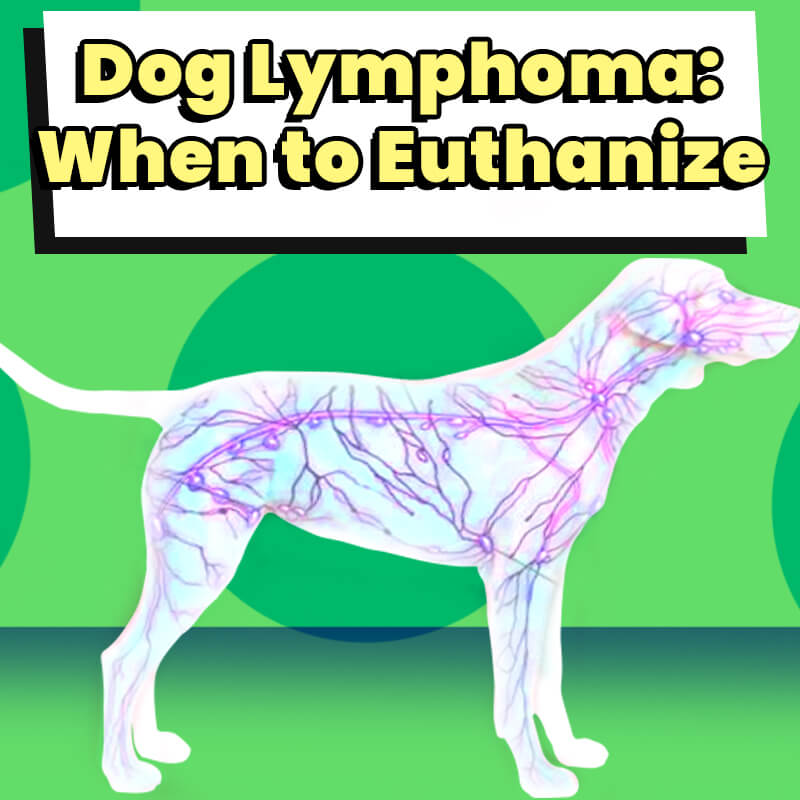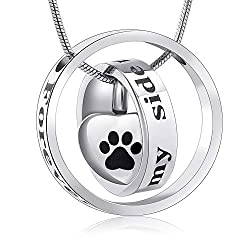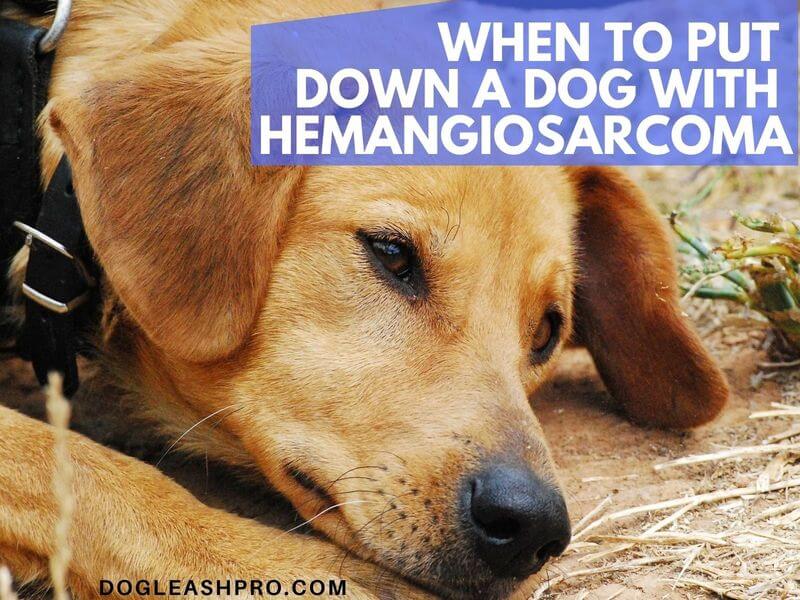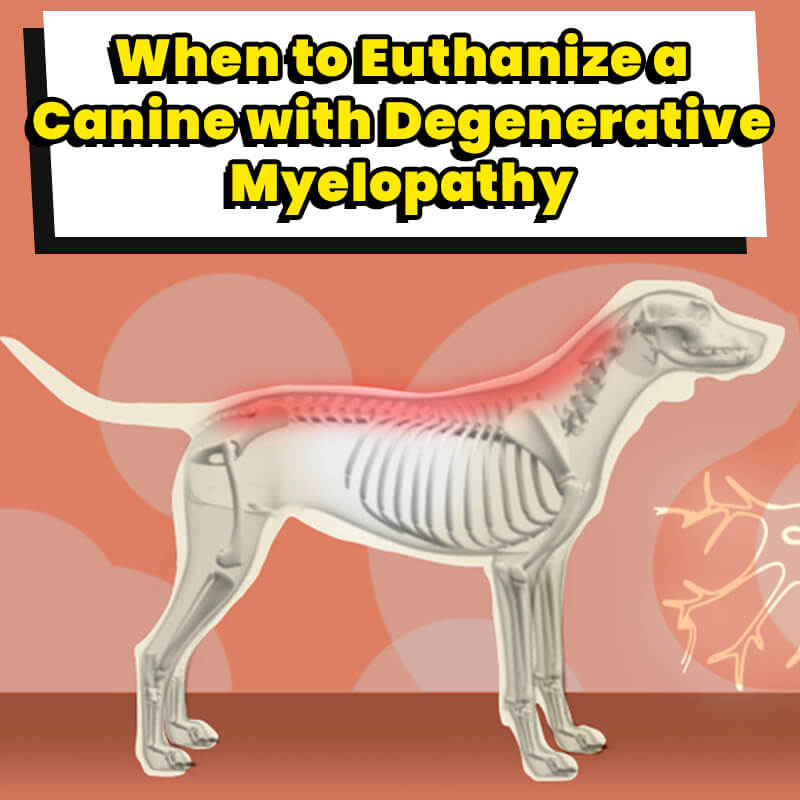
My best friend’s dog, Ollie was diagnosed with lymphoma a year ago. The emotional rollercoaster is still raw and inspired me to write this blog. She tried everything. It didn’t get better and she took the vet’s advice on when to put Ollie down to sleep.
When to put a dog down with lymphoma? If your dog has lymphoma, it’s best to put them down if they are not getting any better from the treatments provided, continues to be in pain, or have lost their appetite. Although this sounds harsh, euthanasia will free them from further suffering.
If you’re feeling shocked like we were, I hope you continue reading. Depending on which type of lymphoma your dog has, some of the symptoms may look like your dog has dementia so be sure to read our blog on dementia in dogs: when to euthanize to rule out other possible causes.
Table of Contents
What is Lymphoma in Dogs?
Dogs like humans can have lymphoma. In dogs, it’s called canine lymphoma. The complex disease affects the body’s lymphocytes, which are a type of white blood cell throughout the lymphatic system. Dogs have lymphoma when these cells become abnormal.
The lymphatic system includes the lymph nodes, spleen, tonsils, bone marrow, and lymphatic vessels, which help the immune system fight off infections and toxins. Lymphocytes are highly concentrated in these organs.
Speaking of lymph nodes, they are located all over your dog’s body. Since lymphocytes live in lymph nodes, the bloodstream, and all over the body, this cancer may be in one particular region or spread throughout the dog’s entire body.
As such, lymphoma is a cancer of the lymphatic system and lymph nodes. Some or all of the lymph nodes may be affected.
In fact, it’s possible to see or feel the affected lymph nodes that are near the body’s surface. They are usually very firm and big.
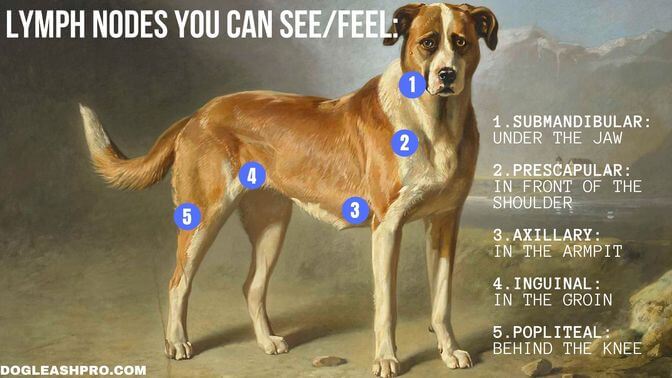
4 Common Types of Lymphoma
Believe it or not, there are more than 30 different types of lymphomas in dogs. All vary in clinical signs, aggressiveness, and survival rates. But there are four common types of canine lymphoma that recur more than the others.
They are:
- Multicentric lymphoma
- Alimentary lymphoma
- Mediastinal lymphoma
- Extranodal lymphoma
Multicentric Lymphoma
Up to 85 percent of canine lymphoma cases are multicentric lymphoma. As such, this is the most common type of lymphoma. The lymph nodes are affected in which they swell up very quickly.
Alimentary Lymphoma
If a dog has alimentary lymphoma, intestinal symptoms will occur. Accounting for less than 10 percent of canine lymphomas, this is the second most common type.
Mediastinal Lymphoma
Compared to others, mediastinal lymphoma occurs much less often. In this cancer, the presence of high-grade malignant T lymphocytes causes the thymus and the mediastinal lymph nodes in the chest area to swell up.
Extranodal Lymphoma
Extranodal lymphoma targets your dog’s eyes, kidneys, lungs, central nervous system, and skin. The most common extranodal lymphoma in dogs is called cutaneous lymphoma which affects the skin.
What Causes Lymphoma in Dogs?
Sadly, scientists still do not know what causes canine lymphoma or where it came from. Some studies believe that exposure to harmful substances such as magnetic field exposure or phenoxyacetic acid herbicides can cause lymphoma.
Dogs can also develop lymphoma due to other cancer-causing environmental factors. For now, no one knows the exact cause. We will stay on top of this and when we do find more information, we’ll let you know.
While we may not know what causes canine lymphoma, we do know that there are treatments available if your dog is suffering from lymphoma.

Helping you decide when to euthanize your dog with lymphoma
If you think your dog is suffering from lymphoma or the treatment proves ineffective, contact your veterinarian right away. Together, they will help you make a decision about the right time to euthanize your dog.
Avoid making hasty decisions. Asking for help from vets and qualified professionals can take the stress and confusion out of the decision-making and give you peace of mind.

Total Time Needed :
6
Months
30
Minutes
Total Cost:
50
USD to 300+ USD
Required Tools:
Things Needed?
Steps to decide if you should euthanize your dog with lymphoma:
Common Symptoms of Lymphoma in Dogs
Symptoms and signs of lymphoma in dogs are important as early detection is key. The symptoms vary depending on which type of lymphoma your dog has.
Multicentric Lymphoma Symptoms in Dogs
When dogs have multicentric lymphoma, the first symptom is usually swollen lymph nodes. Dogs with lymphoma can have lymph nodes that are three to ten times their normal size.
The lump moves freely inside the dog’s skin and feels firm and rubbery.
Although the swollen lymph nodes do not hurt, dogs with multicentric lymphoma may develop weakness, dehydration, fever, lethargy, and anorexia.
Alimentary Lymphoma Symptoms in Dogs
Alimentary lymphoma affects the intestines so your dog may vomit or have diarrhea, weight loss, anorexia, and abdominal pain.
Mediastinal Lymphoma in Dogs Symptoms
When dogs have mediastinal lymphoma, they have difficulty breathing. It could be due to one of two reasons:
- A large mass is present in the chest or,
- Fluid is accumulated in the chest (pleural effusion)
Sometimes, the dog’s face or front legs may even swell up. You’ll notice that they are often very thirsty which causes them to urinate more than usual.
Extranodal Lymphoma in Dogs Symptoms
Extranodal lymphoma can target many organs so the symptoms depend on which organ it affected.
Here is a list of examples:
- If the skin is affected, symptoms include raised nodules or dispersed scaly lesions. This can appear in the mouth and affect the dog’s gums, lips, and the roof of the mouth.
- When the lungs are affected, symptoms include respiratory distress.
- Extranodal lymphoma in the kidneys causes renal failure.
- When the disease affects the eyes, it can cause blindness.
- Lymphoma in the central nervous system leads to seizures.
- If the bones are affected, lymphoma can cause fractures or pain.
Which dog breeds are predisposed to Lymphoma?
Certain dog breeds are at an increased risk of developing lymphoma. These include:
- Airedale Terriers
- Basset Hounds
- Boxer Dogs
- Bulldogs
- Bullmastiffs
- Golden Retrievers
- Saint Bernards
- Scottish Terriers
Lymphoma in dogs diagnosis
If you suspect that your dog may have lymphoma, visit your veterinarian right away. Your vet will check your dog’s body thoroughly and perform a variety of tests. They’ll take samples of the affected organs to get an accurate diagnosis.
For instance, the vet will perform either a fine needle aspiration or a biopsy. A thin needle is inserted to extract a sample of the dog’s lymph nodes or organs. It’s a quick and simple procedure with only minimal discomfort. The dog can be awake or under mild sedation during this test.
A Specialist in a laboratory will perform a cytology exam in which she looks at the samples under a microscope to accurately assess the tumor. A histopathologic tissue evaluation may even be performed.
Depending on the size of the tumor, a biopsy may be required to remove a larger sample of tissues. In this case, the dog will be put under a general anesthetic.
After the lymphoma diagnosis, some vets may perform staging tests to understand the dog’s overall condition as well as the cancer. This is to see how far the disease has progressed throughout the dog’s body.
At the BluePearlVet, these tests include bone marrow aspiration, abdominal sonograms, x-rays, urinalysis, ultrasound scan, and blood tests. All the diagnostic information is gathered to give an accurate prognosis and provide appropriate treatment options.
What are the stages of lymphoma in dogs?
There are 5 stages of lymphoma in dogs with stages 3 and 4 being the detectable stages for multicentric Lymphoma:
Stage 1: Single lymph node is involved.
Stage 2: Presence of multiple nodes on one side of the diaphragm.
Stage 3: Presence of multiple nodes on both sides of the diaphragm.
Stage 4: The liver or the spleen is affected.
Stage 5: Spread of the disease in the bone marrow, the central nervous system, and other extranodal sites.
How long does end stage lymphoma in dogs last?
Signs of end-stage lymphoma include diarrhea, extreme lethargy, nausea, loss of appetite, and weight loss.
The enlarged lymph nodes can also hinder breathing and cause noisy inhalation when it is blocking the air passageway.
End-stage lymphoma can last approximately 2 months for dogs who are untreated but undergoing steroid medication.
For dogs who have undergone chemotherapy, life expectancy can be extended from 8 months to 2 years.
Treating Lymphoma in Dogs
Treatments or disease remission are crucial to make your dog feel better again for a period of time, with minimal side effects. While lymphoma is not completely eliminated, it is not present at detectable levels.
According to the College of Veterinary Medicine Purdue University, the most effective treatment therapy for dogs with lymphoma is chemotherapy because it helps to stop or hinder cancer cells from growing or dividing.
Lymphoma can spread to multiple areas of the dog’s body so chemotherapy is more effective than surgery.
Depending on the type of cancer, the type of chemotherapy varies. Some cases may require radiation therapy or surgery. For instance, dogs with multicentric lymphoma and have swollen lymph nodes will be given the chemotherapy protocol UW-25.
Chemotherapy protocol UW-25 is based on the CHOP protocol used in humans who have non-Hodgkin lymphoma.
If a dog has cutaneous lymphoma, the most effective chemotherapy protocol is lomustine or CCNU.
As you can see, many veterinarians and human doctors use almost the same chemotherapy protocols to treat lymphoma in their patients because canine lymphoma is similar to non-Hodgkin’s lymphoma in humans.
Fortunately, chemotherapy does not usually make dogs as sick as it does to humans. Unlike humans who will lose their hair during this treatment, dogs rarely lose their hair. There are a few exceptions. Dog breeds such as Bichon Frise, Old English Sheepdogs, and Poodles may lose their hair.
In dogs, the most common side effects of chemotherapy include loss in appetite, diarrhea, mild vomiting, and decreased activity levels.
Dog Lymphoma Life Expectancy
As soon as dog owners find out their furry friends are diagnosed with lymphoma, their immediate question is, how long can my dog live with lymphoma?
Many pet owners want to know what to expect, how to react emotionally, and make the necessary arrangements for their dog’s care and treatments.
Unfortunately, there is no simple answer.
How long your dog has to live depends on several factors, including which type of lymphoma your dog has, how aggressive it is, what stage the cancer is at the time of treatment, and which type of treatment you choose.
American College of Veterinary Internal Medicine did point out that, “Approximately 20% of dogs can survive more than two years with currently available treatments. Most owners are very happy with the clinical outcome and response to therapy.”
What can I feed my dog with Lymphoma?
A diet filled with easy-to-digest fatty proteins is recommended, like chicken, pork, fish, turkey, and eggs.
Be sure to avoid beef as it is more difficult to digest.
Supplements with antioxidants and omega-3 fatty acids can help reduce inflammation and improve their immunity.
Additionally, foods rich in flavonoids like pomegranates can reduce tumor growth.
When should I stop chemotherapy on my dog?
Since a dog typically doesn’t have adverse side effects from chemotherapy, they can undergo the treatment several times.
Treatment can be stopped if the cancer is in remission, or a dog can stay with the treatment sporadically until there is an improvement in their condition.
When to Euthanize Your Dog with Lymphoma?
Since finding out your pup has lymphoma, you’ve decided that chemotherapy is the best option. But now you’re wondering what to do when that day comes. When should you put your dog down? When is the right time?
The chemotherapy seems to work, but you know it won’t cure your furry friend entirely of this cancer. Now you’re wondering, when should you put your dog down?
If your dog is being treated and seems to be living a normal life where he is breathing well, eating well, and living a good quality of life, there’s no need to consider euthanisation. Make sure to visit your vet frequently.
However, if your dog is suffering from lymphoma even with the treatment, then it may be appropriate to consider euthanization. Here are scenarios where you may consider euthanasia.
- Your dog is experiencing many uncomfortable symptoms such as diarrhea, lack of energy, vomiting, and is in pain.
- If your dog’s quality of life is diminishing and you don’t think it will get better.
- You sense that your pup is feeling depressed or miserable.
- The lymphoma treatments provided by your vet have not been helpful.
Seeing your dog suffer and watching him in misery every day is very difficult. If you have family members, they may also witness your dog suffering as well.
We advise that you discuss it over with your vet or other medical professionals if you’re thinking of euthanizing your dog with lymphoma. They may recommend other treatments available or agree with your decision to euthanize.
If euthanisation is the final decision, your vet will provide you with any resources you need during this hard time.
How does dog euthanasia work?
During the euthanization process, the veterinarian will handle the entire procedure. They will answer any questions you have. If you have a large dog breed, he will lie down on a table for the procedure. If you have a small dog breed, your vet’s assistant will hold him.
Your veterinarian will administer an injection of sodium pentobarbital with a syringe. It is an anesthetic drug. Your dog will quickly lose consciousness and the heart will stop painlessly. When the heart stops beating, your vet will confirm the time of death and allow you a few moments with your dog.
This is the last time you will see your pet. It’s best to mentally prepare yourself to say goodbye. Remember the happy memories you had with your furry friends and know that they are now free from pain.
It’s ok to cry and know that you made the humane decision to not see your furry family member suffer. You’ve given them a painless and quick end to their suffering.
Remembering your dog
After the euthanization procedure, you’ll want to remember your dog. Your dog’s vet may suggest either a traditional burial (at a pet cemetery or in your backyard if your town allows it) or a cremation.
People often choose to cremate their beloved furry companions in order to keep their remains in an urn to keep in their house. Fortunately, there are many urns available online with customization to make them the perfect resting place for your dog.
My best friend went with this one. She places it in her living room and it matches the furniture. She always smiles whenever she walks past it because it reminds her of their happy times together.
Pet Insurance
Treatments for dogs with lymphoma can be costly. If you’re going the treatment route and it’s too expensive, consider getting pet insurance. With pet insurance, it can go a long way to helping you pay for your dog’s treatment.
We advise getting pet insurance before you need it. It will help your family pay for treatments if anything happens to your dog.
Over the past couple of years, private pet insurance has been growing. Don’t wait until your pet needs insurance to get it. Signing your pet up to be covered early can help keep monthly payments low and give you peace of mind.
Coping with loss and dealing with grief
You have the peace of mind that your dog is in a better place now without suffering further pain. But you feel sad and want to know how to deal with this loss. We’d like to share some helpful tips for coping with the loss of your dog.
- It’s ok to grieve. You can do this privately or share your feeling with your spouse or friends. Letting your feelings out will help you feel better. Try not to hide or bottle up your feelings.
- Memorial for your dog. You and your family members have been affected by this loss. Hold a small memorial service so you can all say good bye to your dog.
- Share favorite memories of your dog. As a family, have everyone share their happy memories spent together with the dog.
- Try not to feel guilty. I know it hurts that our dog died of euthanasia, but it was so that they no longer feel pain or suffering.
- Support system. Within the first few weeks, meet with your support system and discuss your feeling openly. This will help you work through your emotions and help you realize you’re not alone in this.
Conclusion
Although there are certain dog breeds that are more prone to canine lymphoma, this cancer can really occur in any dog breed. Lymphoma can appear in one part of the body or in multiple locations.
As pet owners, we may not be able to cure the disease entirely. But we can do our best to ensure our dogs are being treated to slow down the cancer cells. If treatments fail our dog and our dog is miserable, it may be a wise decision to consider putting them down.
We understand how you’re feeling right now because we’re also currently going through it too. It’s hard and it’s painful. I hope you find this blog helpful and it helps you with your decision-making.
Related Questions
Yes, if your dog has Lymphoma and is left untreated, then he may only have about 3 to 4 weeks to survive. During their final 3 to 4 weeks left, they may live a bad quality of life and may be in constant pain.
Unfortunately, this is usually the case when dog owners do not have pet insurance for their canine companions or are not able to afford it.
Treatment is usually the best course of action if your pup has been diagnosed with lymphoma as this disease is treatable. This is why we can’t emphasize enough the importance of pet insurance and why getting one for your furry friends is crucial.
Don’t wait until there is a health problem to sign up for pet insurance. Find out which pet insurance is best for your four-legged friend and sign up today.
There are several ways and signs to know when it is time to put your dog down with lymphoma. If you suspect your dog has Lymphoma, make sure to consult with your dog’s vet immediately. Time is of the essence here.
Detecting Lymphoma early is key to preventing this disease from getting further along. Your vet will perform a series of tests and examinations to confirm that your dog has Lymphoma.
Unfortunately, there is no cure for Lymphoma. However, there are certainly a number of effective treatments that may be available to your dog with chemotherapy being the most effective treatment to slowing down or even stopping the growth of cancer cells.
In some cases, the treatments may not work and your canine friend’s quality of life worsens. Your dog may shake a lot, go potty inside the house, have difficulty breathing, panting heavily, not eating, limping around, or feeling sad. When this happens, you’ll have to make the hard decision on whether to put down your dog with Lymphoma.
If you know your dog has Lymphoma, you’ll want to contact your vet as soon as you can and seek treatment options for your dog right away. Getting treatments right away is key because if the condition is left untreated, your dog with Lymphoma may only have 2 to 4 weeks to live. Ask your vet for the best treatment option for your four-legged friend.
DISCLAIMER: THIS WEBSITE DOES NOT PROVIDE MEDICAL ADVICE
The information, including but not limited to, text, graphics, images and other material contained on this website are for informational purposes only. No material on this site is intended to be a substitute for professional veterinary advice, diagnosis, or treatment. Always seek the advice of your veterinarian or other qualified health care provider with any questions you may have regarding a medical condition.

With over five years of specialized experience as an animal writer, my expertise lies in dog nutrition, health, behavior, grooming, and training. I am dedicated to delivering helpful and informative content that caters to the well-being of our furry friends. My primary goal is to empower pet owners with knowledge and ensure our canine companions thrive in health and happiness. In my free time, I love volunteering at local dog rescue centers.
